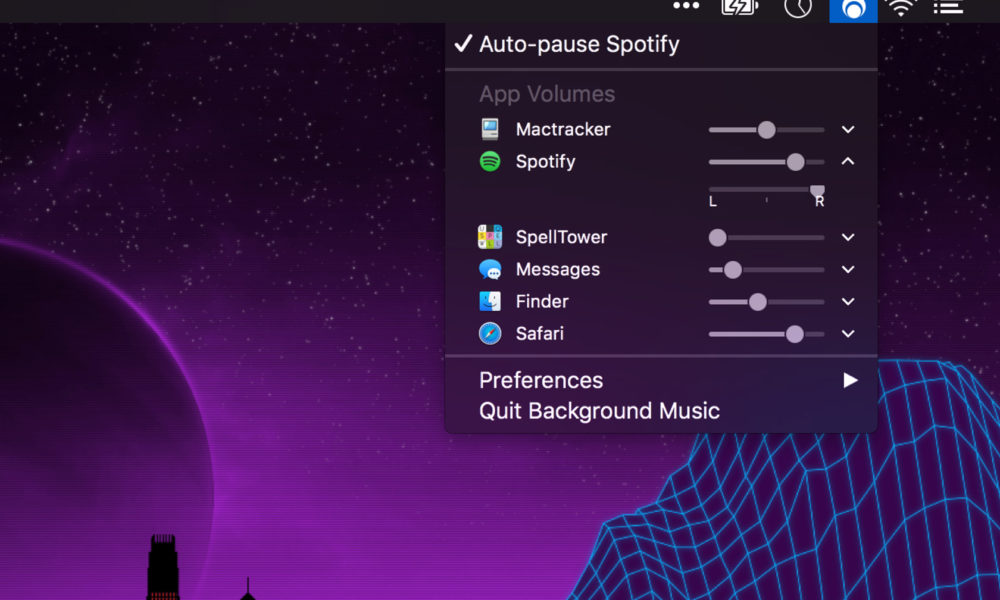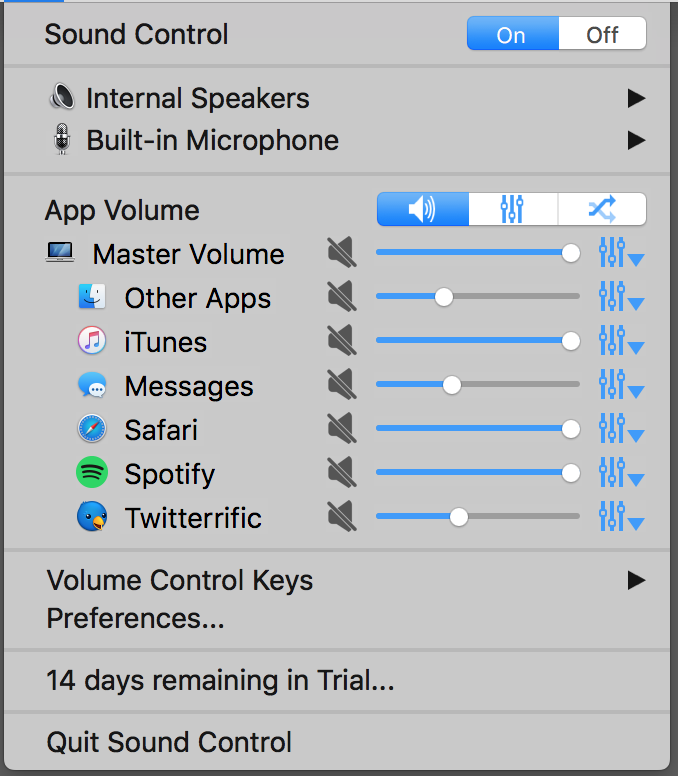- Volume Control For Messages
- Remote Volume Control For Mac
- Volume Control For Mic
- Volume Control For This Mac
This article aims to help you troubleshoot and fix sound problems. More specifically, several Mac users have reported that they are unable to change/adjust sound/volume.
Do you think that your Mac’s volume control is not working?
To change the volume on your Mac, click the Volume control in the menu bar, then drag the slider to adjust the volume (or use the Control Strip). If the Volume control isn’t in the menu bar, choose Apple menu System Preferences, then click Sound. Click Output, then select the “Show volume. SoundSource 4 review: The Mac audio control app Apple should have made Menu bar utility for changing the volume, output, and audio device settings on your Mac. Sometimes, the volume buttons on a MacBook can be pretty annoying. It's too loud, so you turn it down one notch, and now you can't hear your movie at all. It's too low, so you turn it up one notch, and now you can't even hear yourself think. But, there's something a lot of Mac users don't know—that you can adjust the volume in Mac OS X in ¼ increments. USB Volume Control, AIMOS Lnline Volume Knob Lossless Audio Computer with 6.57ft USB Cable Mute Volume Control and PC Speakers Switch Control Module for XP, MAC.
If you can’t adjust volume, here is how you can fix:
SoundBunny is a simple Mac volume control application that allows you to control the volume level for all open applications on your Mac. You can set the volume high for a movie or game you’re playing, while setting the volume low for your alerts or notifications. SoundBunny is sound control for Mac SoundBunny lets you manage the volume.
Please complete each step before moving on.
Sound Settings
If the audio stops working properly in macOS, the first thing you should do is to go to System Preferences > Sound > Output and check your sound settings. Make sure that your settings are correct.
When you press the volume keys, do you see an image like this:
That also your internal speakers are disabled. You can select a device you want to use in the list of output devices if you have multiple devices. These devices can be headphones plugged into your Mac, external speakers or AirPlay devices.
For example, as you can see below, if the Sharp TV is selected, you will get the volume icon like above if you try to adjust the volume on your Mac. You will have to use the Sharp TV for volume adjustment.
Make sure you have the correct device for your audio selected.
Restart your Mac
Restart your Mac. This may help. (Apple menu > Restart…)
Reset Core Audio
You may want to reset the Core Audio process. Here is how:
Launch Terminal and enter the following command:
Then press enter (you may need to enter your admin password).
You can also do this using Activity Monitor. Here is how:
- Open Activity Monitor on your Mac.
- Type coreaudiod in the search box.
- Select it.
- Click on the X to quit it. This will manually kill the process.
The coreaudiod process should restart itself.
Reset PRAM / NVRAM
Volume Control For Messages

Speaker volume information is stored in PRAM (on older Macs) or NVRAM (on newer Intel-based Macs). Resetting this may resolve your problem. Here is how:
- You may want to print these steps, as the process involves turning off your Mac.
- Turn off your Mac (Apple menu > Shut Down…).
- Press the power button to turn on your computer.
- press and hold the Command, Option, P, and R keys at the same time, after you hear the startup sound. Note that it is important you press these keys before the Apple logo appears.
- Keep holding the keys until your Mac restarts.
- When you hear the second startup sound, release the keys.
You may also want to reset SMC.
Update your Mac
Make sure that you are running the latest version of macOS. You can easily update your Mac by going to System Preferences > Software Update. And if there is an update available, follow the onscreen instructions.
If your Mac is running macOS High Sierra or earlier, then open the App Store app on your Mac to update your Mac.
Audio Midi Setup
Remote Volume Control For Mac
Launch Spotlight (Command-Space). Make sure that:
- “Built-in Output” is selected
- “44100 HZ” and “2ch-16 bit Integer” is selected
If you are still having this problem, you may want to contact Apple Support. You may have a hardware problem, you may need to make an appointment at an Apple Store.
See also:
One area where Windows has been leaps and bounds ahead of the Mac for years, if not decades, is volume control. Quite simply, sometimes you need to control volume on a finer level than OS X allows. Windows lets you adjust output volume for each individual application, but this isn’t possible natively on a Mac.
Volume Control For Mic
So we have to turn to third-party apps to grant us this ability. Both apps on this list offer the feature of adjusting volume by app. However, the apps each bring something different to the table, so explore the options and decide for yourself which is best.
Volume Mixer
Volume Mixer is the first Mac app on the list and it allows you to control system volume by application. The app sits in your menu bar so you can call it up as needed. Each app, much like on Windows, is accompanied by its own volume slider. Adjust it as you’d like, mute individual apps entirely or click Refresh to bring an app on par with the master volume.
Over in the Preferences, you can choose your default output source or just quickly change sources on the fly. You can also set highly convenient keyboard shortcuts for specific actions revolving around volume control. These include increasing the volume of an active app, decreasing the volume of an active app, toggling mute for an active app, increasing/decreasing/muting background sound and increasing/decreasing/muting notifications. If you want full control over your output audio, it doesn’t get much better than this.
Volume Mixer comes with a free seven day trial after which it’s $9.99 for two copies or $14.99 for lifetime updates. It’s fairly steep pricing, but if you need the features, it works great.
Background Music
Background Music is a simpler app that does much of the same thing as Volume Mixer. From your menu bar, you can adjust volume for individual applications. But in Background Music, the volume sliders aren’t relative to your master volume. Each slider by default is set to the middle and doesn’t change when you raise or lower your volume. That means that technically, if you have your volume all the way up, you could still give some apps a slight boost.
It also has a phenomenal feature that auto-pauses your music when another source of audio starts playing, then automatically continues playback when the other audio stops. It’s much like how music stops and resumes when you get a phone call on your iPhone. The auto-pause feature supports iTunes, Spotify, VOX and VLC.
Background Music is free, unlike Volume Mixer, but since the developer hasn’t officially published it anywhere, it must be installed from GitHub.
Note: The guide to installing Background Music is right on the GitHub page. If you have Xcode installed, just copy and paste the provided prompt into Terminal.
To manually install, download the ZIP file and unzip it. In Terminal, type cd followed by the path to where you unzipped the folder. Then install by typing /bin/bash build_and_install.sh.
ALSO SEE:How to Live Monitor Your Microphone Input on Mac
The above article may contain affiliate links which help support Guiding Tech. However, it does not affect our editorial integrity. The content remains unbiased and authentic.
Volume Control For This Mac
 Also See#audio #music
Also See#audio #music Did You Know
In November 2017, an Amazon Echo device in Germany started playing music on its own at two in the morning.
More in Mac
Top 4 Ways to Fix Mac Desktop Icons Missing or Not Showing
